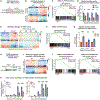Leukemia mutated proteins PHF6 and PHIP form a chromatin complex that represses acute myeloid leukemia stemness
- PMID: 40721297
- PMCID: PMC12340699
- DOI: 10.1101/gad.352602.125
Leukemia mutated proteins PHF6 and PHIP form a chromatin complex that represses acute myeloid leukemia stemness
Abstract
Myeloid leukemias are heterogeneous cancers with diverse mutations, sometimes in genes with unclear roles and unknown functional partners. PHF6 and PHIP are two poorly understood chromatin-binding proteins recurrently mutated in acute myeloid leukemia (AML). PHF6 mutations are associated with poorer outcomes, whereas PHIP was recently identified as the most common selective mutation in Black patients with AML. Here, we show that Phf6 knockout converts Flt3-ITD-driven mouse chronic myelomonocytic leukemia (CMML) into AML with reduced survival. Using cell line models, we show that PHF6 is a transcriptional repressor that suppresses a limited stemness gene network and that PHF6 missense mutations, classified by current clinical algorithms as variants of unknown significance, produce unstable or nonfunctional protein. We present multiple lines of evidence converging on a critical mechanistic connection between PHF6 and PHIP. We show that PHIP loss phenocopies PHF6 loss and that PHF6 requires PHIP to occupy chromatin and exert its downstream transcriptional program. Our work unifies PHF6 and PHIP, two disparate leukemia mutated proteins, into a common functional complex that suppresses AML stemness.
Keywords: chromatin; leukemia; myeloid; stemness.
© 2025 Pawar et al.; Published by Cold Spring Harbor Laboratory Press.
Conflict of interest statement
Competing interest statement
The authors declare no competing interests.
Figures







Update of
-
Leukemia-mutated proteins PHF6 and PHIP form a chromatin complex that represses acute myeloid leukemia stemness.bioRxiv [Preprint]. 2024 Dec 18:2024.11.29.625909. doi: 10.1101/2024.11.29.625909. bioRxiv. 2024. Update in: Genes Dev. 2025 Oct 1;39(19-20):1219-1240. doi: 10.1101/gad.352602.125. PMID: 39677666 Free PMC article. Updated. Preprint.
References
-
- Abdelfattah A, Hughes-Davies A, Clayfield L, Menendez-Gonzalez JB, Almotiri A, Alotaibi B, Tonks A, Rodrigues NP. 2021. Gata2 haploinsufficiency promotes proliferation and functional decline of hematopoietic stem cells with myeloid bias during aging. Blood Adv 5: 4285–4290. doi: 10.1182/bloodadvances.2021004726 - DOI - PMC - PubMed
-
- Alvarez S, da Silva Almeida AC, Albero R, Biswas M, Barreto-Galvez A, Gunning TS, Shaikh A, Aparicio T, Wendorff A, Piovan E, et al. 2022. Functional mapping of PHF6 complexes in chromatin remodeling, replication dynamics, and DNA repair. Blood 139: 3418–3429. doi: 10.1182/blood.2021014103 - DOI - PMC - PubMed
MeSH terms
Substances
Grants and funding
LinkOut - more resources
Full Text Sources
Medical
Molecular Biology Databases
Miscellaneous
